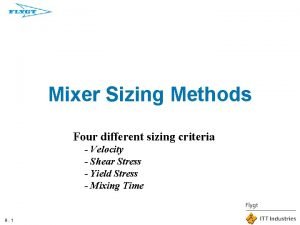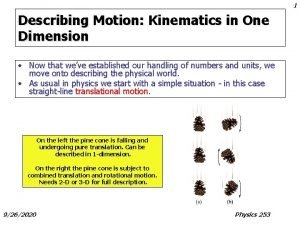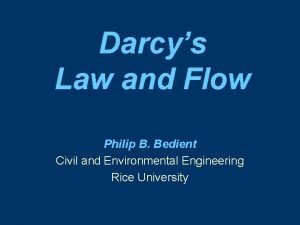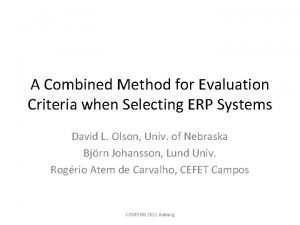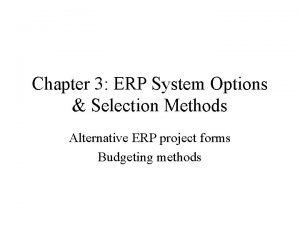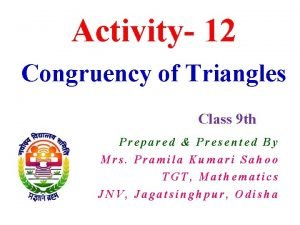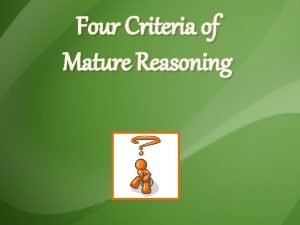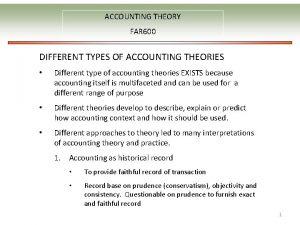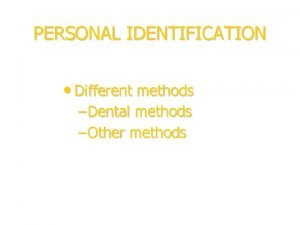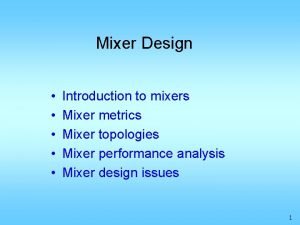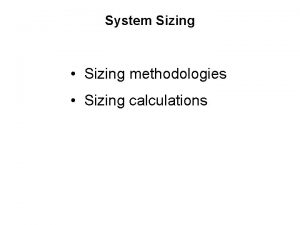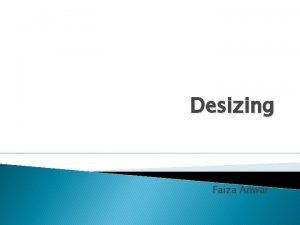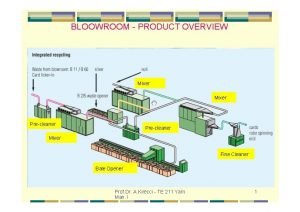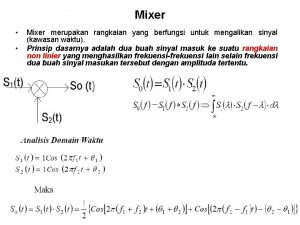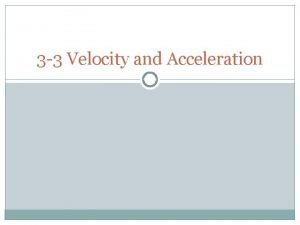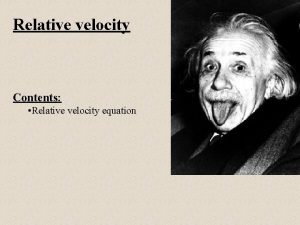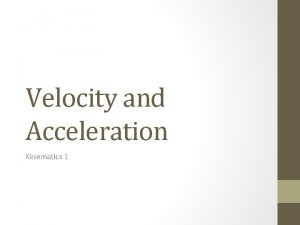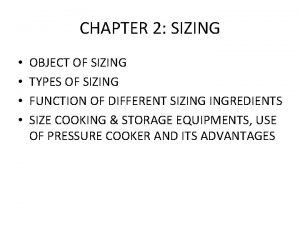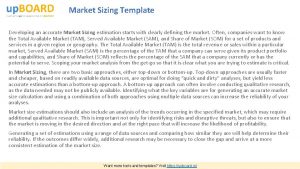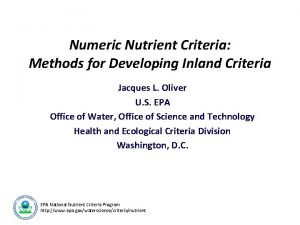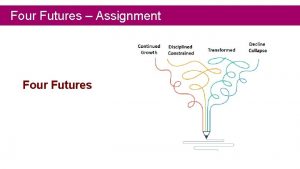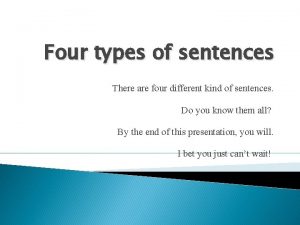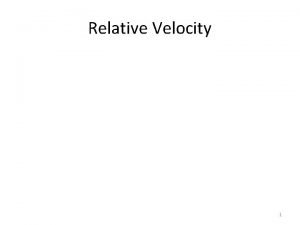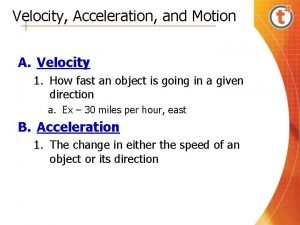Mixer Sizing Methods Four different sizing criteria Velocity
























- Slides: 24

Mixer Sizing Methods Four different sizing criteria - Velocity - Shear Stress - Yield Stress - Mixing Time 8. 1

Velocity Mixing Duties – Circulation • u specified • heat or mass transfer specified • . . . – Homogeneous suspension • u depends on usettl and tank geometry • Standard u values in biological treatment systems 8. 2

Velocity Required thrust = (Size of Mixer) = Freq ~ u 2 k & • Losses (k) - Racetrack – Bends – Friction wall & bottom – Aeration – Obstacles 8. 3 • Losses (k) - Other tanks – Tank factor (geometry) – Propeller factor – Aeration – Obstacles

Shear Stress Mixing Duties – Off bottom suspension & Resuspension of sediment • Shear Stress calculated • Shear Stress measured • By experience – Erosion and transport of sediments 8. 4

Shear Stress Required thrust = (Size of Mixer) = • ts = Requires Shear stress to resuspend – measured – calculated – Experience 8. 5 F ~ ts

Yield Stress For mixing to be possible, the fluid must move at all. If it has a finite Yield Stress, this must be overcome. Hence this is an additional mixing criterion, often decisive. Applications – Thickened sludge – Paper pulp – Drilling mud – Slurries. . . 8. 6

Yield Stress Required thrust = (Size of Mixer) = • where ty is – Calculated or measured for municipal sludge, drilling mud & paper pulp – Specified by client – Measured by e. g. ITT Flygt Application Lab / known otherwise 8. 7 F ~ ty

Mixing Time Mixing Duties – Required blending time Q specified or given by • Throughflow; fluid leaving tank is mixed to a certain homogeneity xb. • Batch; customer requires a certain maximum time Q and a certain minimum homogeneity xb. 8. 8

Mixing Time Required thrust = (Size of Mixer) = • F ~ 1 / Q 2 Specified mixing time Inflow = Q – Given by customer – Given by process Volume = V – Retention time = V/Q 8. 9

Quantified mixing demands 8. 10 • Velocity F ~ u 2 • Shear stress F ~ ts • Yield stress F ~ ty • Time F ~ 1 / Q 2

Extra study 8. 11

Extra study Channels - Required thrust “The velocity Solver” The required thrust is 2 r u Freq = Ab k 2 r is the liquid density (1000 kg/m 3 for water) k = kf + kb + kaer + ko are loss factors due to friction, bends, aerators, other obstacles. Ab is the bulk flow area (projected area of cross section of main flow) 8. 12

A racetrack example r u 2 F = k · --· A b 2 • Wall friction • Bends • Aerators • Obstacles 8. 13

Bulk flow area Ab Height Width 8. 14

Wall friction Surface roughness Length of flow loop 8. 15

Friction loss factor kf = Ltot / (M Rh) Ltot total mean length of channel Rh = Ab / Pw hydraulic radius M » 80 (Inverse) Manning number M is larger for very small channels or very smooth surfaces, and conversely smaller in the opposite cases. Ab 8. 16 Wet perimeter Pw = 2 H + W

Bend loss factors kb 8. 17 1. 5 0. 6 0. 3 -- 1. 5 2. 5 1. 0 0. 8 0. 5 1. 1 1. 4

Bend losses kb = 1, 5 8. 18

Aerator losses • Diffusers act as flow obstacles • Bubble columns increase the hydraulic losses by – causing counterflow to the bulk flow – causing velocity distributions that increase losses on the bottom and on the diffusers 8. 19

Aeration loss factor kaer Bottom diffuser geometry Bottom diffuser density in grid (m-2) hdiff A^ diff 1 m shape ? 1 m 8. 20

Aeration loss factor kaer • • # grids Bottom coverage (%) Air flow Qair (Nm 3/h) Bulk flow velocity u ® kaer 8. 21

Obstacle loss factor ko The loss force from an obstacle is r u 2 F o = 2 A o c D, Projected area Ao And, to use Ab in the Freq - formula, ko = c D A o / A b. c. D is typically between 1. 0 and 2. 0. For the pipe, say Ao = 6. 0 ´ 0. 5 m 2, c. D = 1. 0 ko = c. D Ao / Ab = 0. 125 8. 22

A racetrack example 6 m 1 grid Sanitaire diff, 20% covered area 6 m 50 m H=4 m r u 2 F = k · --- · Abulk 2 0. 302 F = (0. 87 + 2 · 1. 5 + 0. 55 + 0. 125) · 1000 · --- · (6 · 4) = 4774 N 2 friction bends aerators obstacle 2 units 4430 8. 23

Other tank shapes The same principles as in channels. . 2 r u Freq = Ab k 2 8. 24
 Mixer sizing calculations
Mixer sizing calculations Darcy law
Darcy law Linear and angular quantities
Linear and angular quantities Initial velocity and final velocity formula
Initial velocity and final velocity formula Is v final velocity
Is v final velocity Constant acceleration speed time graph
Constant acceleration speed time graph Instantaneous velocity vs average velocity
Instantaneous velocity vs average velocity Darcy law example
Darcy law example Angular velocity to tangential velocity
Angular velocity to tangential velocity Angular acceleration formula
Angular acceleration formula Software evaluation criteria
Software evaluation criteria Erp system options and selection methods
Erp system options and selection methods Speed velocity acceleration
Speed velocity acceleration Direct wax pattern technique
Direct wax pattern technique Triangle activity for class 9
Triangle activity for class 9 Four criteria
Four criteria Principle of god pod method
Principle of god pod method Sieve shaker advantages and disadvantages
Sieve shaker advantages and disadvantages Accounting theory
Accounting theory Methods of personal identification
Methods of personal identification On the different methods of translating schleiermacher
On the different methods of translating schleiermacher Different types of errors in numerical methods
Different types of errors in numerical methods Exhausted drug meaning
Exhausted drug meaning Centrifuge separating mixtures
Centrifuge separating mixtures Teaching approaches
Teaching approaches
